Today’s Current Affairs: 24th Jul 2023 for UPSC IAS exams, State PSC exams, SSC CGL, State SSC, RRB, Railways, Banking Exam & IBPS, etc
Table of Contents
Brain Fog:
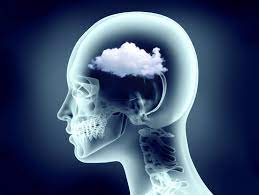
Researchers recently suggested the “brain fog” symptom associated with long Covid is equivalent to ageing 10 years.
- Brain Fog itself is not a medical condition but instead a symptom of other medical conditions.
- It is a term used to describe a variety of symptoms that can affect your ability to think clearly.
- Brain fog is characterized by confusion, forgetfulness, and a lack of focus and mental clarity.
- Some examples of things a person might do because of brain fog include:
- forgetting about a task they had to complete;
- taking much longer than usual to complete simple tasks;
- feeling frequently distracted;
- feeling tired when working;
- Brain fog is typically rooted in a lifestyle that promotes hormonal imbalances.
- Electromagnetic radiation – from computer, mobile phone, tablets
- Stress – reduce blood flow to the brain causing poor memory
- Lack of sleep, no exercise
- Diet: food allergies or sensitivities
- Toxins, pollution, chemical substances, and insecticides
Airbus A400M:
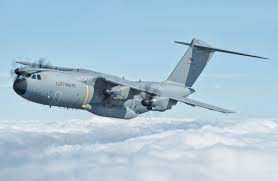
Aircraft manufacturer Airbus recently pitched its A-400M transport aircraft in response to the Indian Air Force’s (IAF) Request For Information (RFI) for a Medium Transport Aircraft (MTA) with a carrying capacity of 18 to 30 tonnes.
- Airbus A400M is a European-built military transport aircraft.
- The aircraft is manufactured by Airbus Defence and Space, a division of the European aerospace and defence firm Airbus.
- It combines the capability to carry strategic loads with the ability to deliver even into tactical locations with small and unprepared airstrips.
- It can carry large cargo, vehicles, troops, and paratroopers or be configured for medical evacuation (MEDEVAC) missions.
- A powerful turboprop engine that gives the A400M the ability to operate from short, unimproved airfields.
- Maximum takeoff weight: 141 metric tons (309,000 pounds)
- Maximum payload: 37 metric tons (41 short tons).
- It can carry up to 116 fully equipped troops or 66 stretchers and 25 medical attendants. The cargo hold can take nine standard military pallets.
- Range: 8,900 kilometres (5,530 miles)
- Speed: 780 kilometres per hour (485 miles per hour)
- The aircraft is equipped with in-flight refuelling capabilities.
- The aircraft’s independent navigation system comprises an inertial reference system (IRS) integrated with a global positioning system (GPS).
- It features an advanced glass cockpit with modern avionics and control systems.
Cam Ranh Bay:
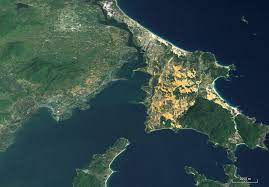
Indian Naval Ship Kirpan will soon be handed over to Vietnam People’s Navy (VPN) at the strategic military port of Cam Ranh Bay.
- Cam Ranh Bay is a deep-water bay located in Khánh Hòa Province, Vietnam, on the South China Sea.
- It is approximately 20 miles (32 km) long from north to south and up to 10 miles (16 km) wide.
- The bay is up to 164 feet (50 m) deep, making it one of the deepest natural harbours in Southeast Asia.
- The port has two main piers, one for general cargo and one for oil tankers.
- It also has a number of other facilities, including a repair yard, a fuel depot, and a container terminal.
- It is a major refuelling and repair station for ships in the South China Sea.
- During the colonial era, it was controlled by the Champa Kingdom and later became part of the Vietnamese territories.
In the 19th century, the French established a major military presence in the bay. - During the Vietnam War, Cam Ranh Bay gained significant importance as a strategic military base for both the United States and South Vietnam.
- The United States constructed extensive facilities, including an airbase and a deep-water port, to support its military activities during the war.
- Following the end of the Vietnam War in 1975, Cam Ranh Bay came under the control of the Socialist Republic of Vietnam.
- The Soviet Union subsequently leased the former American facilities and established a major naval base there.
- The Soviet Navy maintained a presence in Cam Ranh Bay throughout the Cold War until the early 2000s.
Expected Credit Loss (ECL) Framework:

Private sector lender ICICI Bank recently said the bank is ready to move to an expected credit loss (ECL) framework for provisioning.
- The RBI defines a loan loss provision as an expense that banks set aside for defaulted loans.
- Banks set aside a portion of the expected loan repayments from all loans in their portfolio to cover the losses either completely or partially.
- In the event of a loss, instead of taking a loss in its cash flows, the bank can use its loan loss reserves to cover the loss.
- The level of loan loss provision is determined based on the level expected to protect the safety and soundness of the bank.
- The Reserve Bank of India (RBI) recently proposed to move the banking system to an expected credit loss-based provisioning approach from an “incurred loss” approach.
Expected Credit Loss (ECL) regime:
- Under this practice, a bank is required to estimate expected credit losses based on forward-looking estimations rather than wait for credit losses to be actually incurred before making corresponding loss provisions.
- As per the proposed framework, banks will need to classify financial assets (primarily loans) as Stage 1, 2, or 3, depending on their credit risk profile, with Stage 2 and 3 loans having higher provisions based on the historical credit loss patterns observed by banks.
- Thus, through ECL, banks can estimate the forward-looking probability of default for each loan, and then by multiplying that probability by the likely loss given default, the bank gets the percentage loss that is expected to occur if the borrower defaults.
- This will be in contrast to the existing approach of incurred loss provisioning, whereby step-up provisions are made based on the time the account has remained in the Non-Performing Asser (NPA) category.
- It will result in excess provisions as compared to a shortfall in provisions, as seen in the incurred loss approach.
Tiger Orchids:

Tiger Orchids (Grammatophyllum speciosum) bloom at the Jawaharlal Nehru Tropical Botanic Garden and Research Institute (JNTBGRI), Palode, Kerala.
- Tiger orchid is the largest orchid species in the world.
- It is called Tiger Orchid because of its splendid flowers which sport striking brown spots against a yellow backdrop, bringing to mind tigers.
- After 8-12 years of growth, Grammatophyllum speciosum produces flowers in alternate years in its natural habitat.
- It is often grown as an ornamental orchid in gardens and parks for its attractive foliage and large flowers.
- It flowers in January or July, but plants do not flower every year.
- The plant was listed by the Guinness Book of World Records as the world’s tallest orchid, with specimens recorded up to 7.62 metres in height
- Distribution: Malaysia, Indonesia, Thailand, Myanmar and Laos.
- They grow in Terrestrial (Primary Rainforest, Freshwater Swamp Forest, Riverine) habitats.
- Preferred Climate Zone: Tropical, Sub-Tropical / Monsoonal.
- Conservation status
- CITES : Appendix II
Batagaika Crater: Affected Due To Climate Change
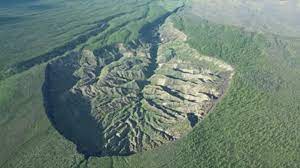
Stunning drone footage has revealed details of the Batagaika crater which is getting affected due to climate change.
- Batagaika Crater is located in Russia’s Far East that forms the world’s biggest permafrost crater.
- Scientists believe that the crater is the result of a melting permafrost land, which was frozen during the Quaternary Ice Age 2.58 million years ago,
- It began to form after the surrounding forest was cleared in the 1960s and the permafrost underground began to melt, causing the land to sink.
- It is also called as “gateway to the underworld,” by some locals in Russia’s Sakha Republic It has a scientific name: a mega-slump.
- This is produced by higher air temperatures, warming climate and anthropogenic impact.
- It holds clues to prehistoric life on Earth. Researchers believe the exposed ice and soil along the crater’s edges could hold up to 200,000 years of geological and biological history.
- The soil beneath the slump, which is about 100 metres deep (328 feet) in some areas, contains an “enormous quantity” of organic carbon that will release into the atmosphere as the permafrost thaws, further fuelling the planet’s warming.
TCRM Matrix:
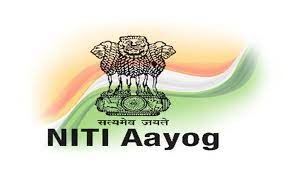
NITI Aayog has introduced the Techno-Commercial Readiness and Market Maturity Matrix (TCRM Matrix) framework, an innovative assessment tool aimed at transforming technology evaluation, encouraging innovation, and nurturing entrepreneurship in India.
- TCRM Matrix stands for Techno-Commercial Readiness and Market Maturity Matrix.
- It is an assessment tool designed to revolutionize technology evaluation, foster innovation, and fuel entrepreneurship in India.
- The framework presents an integrated assessment model that offers in-depth insights and actionable intelligence to stakeholders at every stage of the technology development cycle.
- TCRM framework provides a robust analysis of the joint readiness of a project.
- The scale is intended to give a standard language for innovators, researchers, and investors to communicate about the readiness of a technology for commercialization or deployment.
- The Technology Readiness Level (TRL) was designed to give a framework for assessing a technology’s readiness and communicate more effectively about the risks and opportunities associated with a given technology by utilizing standard language to express the maturity of a technology.
- This framework was developed from the study of innovation from an economic perspective and looks at the increase in performance of a technology over time.
- It finds that from the point of introduction of the technology by an innovator, the improvement in performance of a technology usually starts very slowly with early adopters.
- The Commercialization Readiness Level (CRL) will assess various indicators which influence the commercial and market conditions beyond the technology maturity.
- It assess how a new technology could be commercially successful all the way through to commercial availability and wider acceptance within the target market.
- This enables key barriers to be addressed to support the commercialization of a technology.
- It is intended to supplement the TRL scale by providing increased focus on a technology’s preparedness for market launch and commercial success through specific and clearly defined business indicators.
- Market Readiness Level (MRL) is a methodology used to evaluate how close to the market the project outputs.
- It is used to assess how ready your product or service is to take to market as a commercial offering for a group of customers.
- It relies on extrinsic indicators like the awareness of extrinsic market indicators.
- It is intended to supplement the TRL and CRL by focusing on a technology’s preparedness for the purpose of customer adoption and market success
India Climate Energy Dashboard (ICED) 3.0 : NITI Aayog
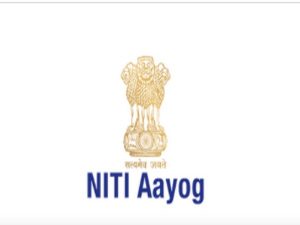
NITI Aayog has launched the India Climate Energy Dashboard (ICED) 3.0, a comprehensive platform providing near real-time data on the energy sector, climate, and related economic datasets sourced from government publications.
- Developed as a user-friendly platform, ICED 3.0 enables users to freely access and analyse datasets using an analytical engine.
- It will facilitate insights and enhance understanding about the energy and climate sectors while identifying the key challenges.
- The Portal will draw insights from the available data parameters and hence immensely useful in monitoring the progress of India’s clean energy transition journey.
- With over 500 parameters, 2000 infographics, and interactive visualizations, ICED 3.0 aids in monitoring India’s clean energy transition progress, identifying key challenges, and offering a holistic view of the country’s energy sector.
Aeolus Wind Satellite : European Space Agency’s

The European Space Agency’s (ESA) Aeolus wind satellite, after exceeding its planned life in orbit, is making its way back to Earth.
- Aeolus Wind Satellite is a satellite mission launched by the European Space Agency (ESA) to study Earth’s winds and their influence on the planet’s climate and weather patterns.
- The mission is named after Aeolus, the ruler of the winds in Greek mythology.
- Aeolus was launched on August 22, 2018, from the Guiana Space Centre in French Guiana.
- It is a 1,360-kilogram satellite.
- The primary goal of the Aeolus mission is to measure global wind profiles from space.
- It aims to provide accurate and comprehensive data on wind patterns in the Earth’s atmosphere to improve weather forecasting, understand climate dynamics, and enhance our knowledge of the Earth’s atmospheric circulation.
- It is the first satellite mission to acquire profiles of Earth’s wind on a global scale.
- Aeolus is equipped with a single instrument called the Atmospheric Laser Doppler Instrument (ALADIN).
- ALADIN is a Doppler wind lidar, which stands for Light Detection and Ranging, that will measure the winds sweeping around the planet.
Advance Authorisation Scheme : Directorate General of Foreign Trade

The Directorate General of Foreign Trade (DGFT) implemented the Advance Authorisation Scheme.
- The Scheme was implemented under the Foreign Trade Policy. It allows duty-free import of inputs for export purposes.
Advance Authorisation Scheme:-
- Launched: 2015. (Advance Authorization Scheme (AAS))
- Ministry: Ministry of Commerce and Industry.
- Objective: to make India’s products competitive in the global market.
- It is a type of duty exemption scheme introduced by the Government of India under the Foreign Trade Policy 2015-2020.
- Under this scheme, exemption from the payment of import duties is given to raw materials/inputs required for the manufacture of export products.
- They are not allowed to sell the products in the domestic market.
- Advance Authorization is valid for 12 months from the date of issue of such Authorization.
- The revised composition fee formula is based on a specific rate for different levels of the ‘CIF (cost, insurance, freight) value of authorization.
- The fees levied under these 3 slabs:-
- ₹5,000 for a cost, insurance, freight (CIF) value of advance authorization license valued at up to ₹2 crores.
- ₹10,000 for a value between ₹2 crore and 10 crores
- ₹15,000 for value over ₹10 crores.
- The simplification of calculations for composition fees helps in automation and faster service delivery by making the process more efficient and easier to understand.
- The eligibility of inputs is determined by Sector-specific Norms Committees based on input-output norms.
- The quantity of inputs allowed for a given product is based on specific norms defined for that export product, which considers the waste generated in the manufacturing process.
- DGFT provides a sector-wise list of Standard Input-Output Norms (SION) under which the exporters may choose to apply.




